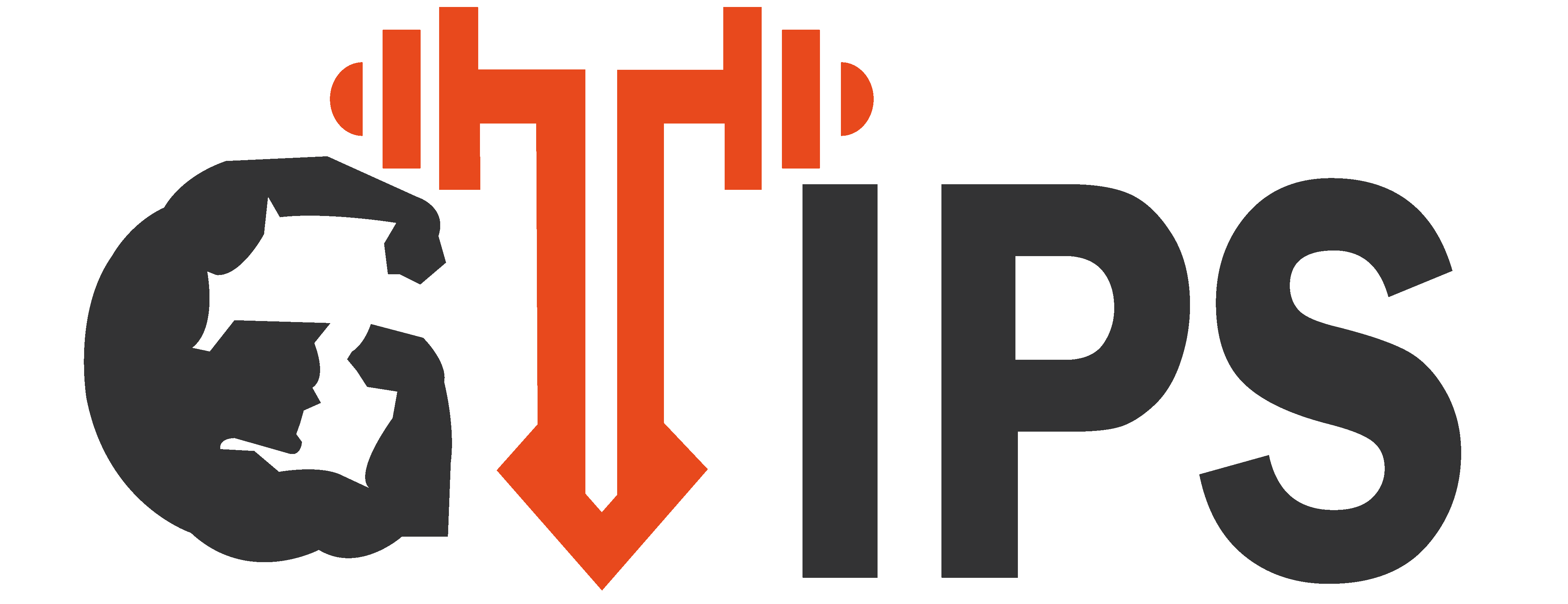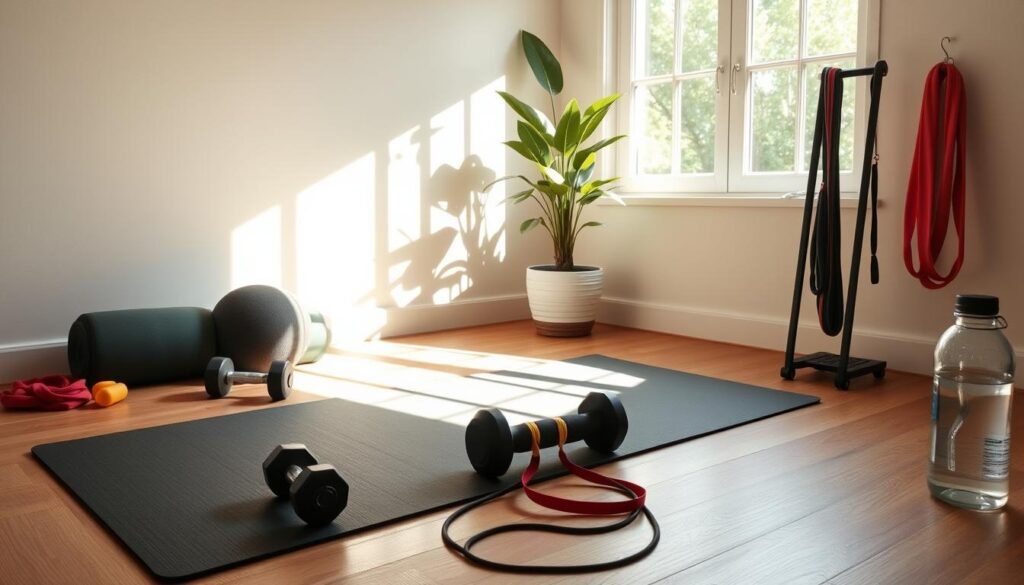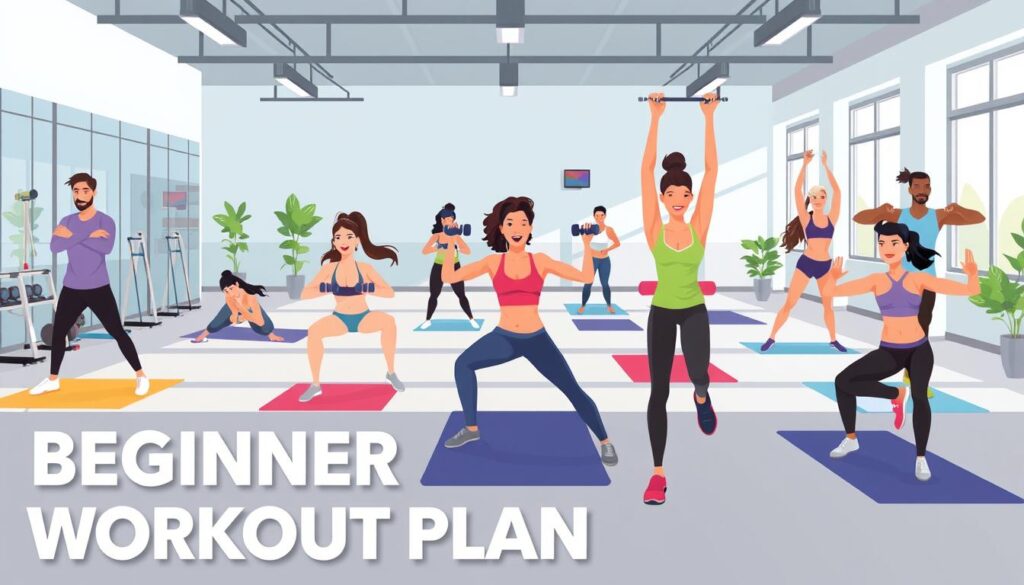Are you ready to start your fitness journey but don’t know where to begin? Creating a good workout routine can seem hard, but it’s key to a healthier life and reaching your goals. This guide will help you get started, whether you want to get stronger, improve your heart health, or just feel better.
Key Takeaways
- Creating a well-rounded workout plan is essential for beginners to build a strong fitness base.
- Beginners should start with 3-4 gym sessions a week, mixing strength training and cardio.
- It’s important to rest and recover between workouts to avoid injuries and support progress.
- Increasing the intensity and duration of workouts slowly is vital for steady improvement.
- Trying different activities and enjoying the process helps keep you motivated in the long run.
Ready to start a healthier, more active life? Check out our detailed guide to find effective workout routines for beginners that will help you succeed.
Understanding the Importance of Regular Exercise for Beginners
Starting a fitness journey can feel overwhelming. Yet, the benefits of regular exercise for beginners are clear. It improves physical health and boosts mental well-being. Adding beginner fitness routines to your life can greatly enhance your overall wellness.
Physical and Mental Health Benefits
Regular physical activity can lower disease risk and enhance balance and coordination. The guidelines suggest 150 minutes of moderate aerobic activity or 75 minutes of vigorous exercise weekly for best health. Also, strength training for major muscle groups at least twice a week is key for a balanced fitness routine.
Setting Realistic Fitness Goals
When starting, setting realistic and achievable goals is vital. Goals might include increasing daily steps, improving cardio, or strengthening specific muscles. Regularly check your progress and adjust your goals to stay motivated and on track.
Building Long-term Habits
Creating a lasting exercise habit is essential for success. Mix activities like high-intensity interval training, moderate aerobic exercise, and strength training to avoid boredom and target different fitness areas. Gradually increase your activity by no more than 10% weekly, allowing for rest and recovery to build a lasting fitness routine.
By understanding the importance of regular exercise and making it a part of your life, you open up a world of beginner fitness, getting in shape, and intro workouts. These will benefit your physical and mental health for years to come.
Essential Components of a Beginner’s Workout Plan
Creating a good workout plan for beginners means balancing different parts. It should match your fitness goals, like getting stronger, improving heart health, or feeling better overall.
A good beginner’s workout plan should have several key parts:
- Aerobic Exercises: Activities like swimming, running, and cycling that make your heart beat faster and boost heart health.
- Strength Training: Exercises like weightlifting or bodyweight exercises that help build muscle and increase strength.
- Calisthenics: Exercises like lunges, pushups, and squats that use your body weight to improve muscle endurance and coordination.
- Flexibility Exercises: Stretching and mobility drills that help you move better and prevent injuries.
Adding High-Intensity Interval Training (HIIT) and balance exercises can make your workout plan even better. It’s important to make the plan fit your goals and fitness level. This way, you get a balanced routine that helps you improve in workout plans for beginners, beginner strength training, and beginner cardio.
| Exercise Type | Benefits | Examples |
|---|---|---|
| Aerobic | Improved cardiovascular health, increased endurance | Swimming, running, cycling |
| Strength Training | Muscle building, increased strength, improved body composition | Weightlifting, resistance band exercises |
| Calisthenics | Muscular endurance, coordination, bodyweight control | Pushups, squats, lunges |
| Flexibility | Improved range of motion, injury prevention | Stretching, yoga |
| HIIT | Improved cardiovascular fitness, fat loss | Sprints, high-intensity circuits |
| Balance | Improved stability, injury prevention | Single-leg exercises, balance training |
“Variety is the spice of life, and it’s also the key to a well-rounded workout routine. Incorporating different exercise modalities will keep your body and mind engaged, leading to better results and a more sustainable fitness journey.”
Effective Workout Routines for Beginners: A Complete Guide
Starting your fitness journey as a beginner is exciting. It’s key to build a strong foundation with good workout routines. Whether you want to get stronger, improve your heart health, or stay healthy, the right plan matters a lot.
Full Body Workout Basics
Full-body workouts are great for beginners. They work out all major muscles in just a few sessions a week. A good full-body workout might include leg press, dumbbell chest press, and hamstring curls.
Cardio Training Fundamentals
Adding cardio to your routine boosts fitness and heart health. Beginners can start with brisk walks, jogging, or cycling. Increase the intensity and time as you get fitter.
Strength Training Elements
Strength training is vital for a balanced workout plan. Beginners should focus on big exercises like squats and bench presses. Use lighter weights and do more reps, then increase the weight as you get stronger.
Start slow and get better over time. Mix full-body workouts, cardio, and strength training. This will help you reach your fitness goals and live a healthy life.
| Week | Workout Routine | Sets x Reps |
|---|---|---|
| 1 | Full-body Strength Training | 3 x 10-12 |
| 2 | Full-body Strength Training + Cardio | 3 x 10-12 |
| 3 | Upper Body Strength + Lower Body Strength | 3 x 8-10 |
| 4 | 4-way Split (Chest/Back, Shoulders/Abs, Legs, Arms) | 3-4 x 8-12 |
“Consistency is the key to long-term fitness success. Stick to your workout routine, and the results will come.”
Creating Your Weekly Workout Schedule
Creating a consistent workout routine is key for beginners to see progress and build lasting fitness habits. It’s important to find a schedule that fits your goals, lifestyle, and preferences. This ensures you stick to it and enjoy the journey.
The Centers for Disease Control and Prevention (CDC) suggest adults do at least 150 minutes of moderate exercise weekly. Or, 75 minutes of vigorous exercise. A beginner’s schedule might include 3-4 workout days with rest days in between.
For a 3-day plan, mix strength training, cardio, and mobility in each session. A 4-day plan could alternate between full-body workouts and cardio/mobility days. The goal is to be consistent and gradually increase your workouts.
| Day | Workout Focus | Duration |
|---|---|---|
| Monday | Full-Body Strength | 45-60 minutes |
| Tuesday | Cardio (Brisk Walking or Jogging) | 30 minutes |
| Wednesday | Rest or Light Activity (Yoga, Stretching) | – |
| Thursday | Upper Body Strength | 45-60 minutes |
| Friday | Cardio (Cycling or Elliptical) | 30 minutes |
| Saturday | Lower Body Strength | 45-60 minutes |
| Sunday | Rest or Light Activity (Walking, Stretching) | – |
This is just a sample plan. The most important thing is to create a routine that suits you. Start slow, be consistent, and gradually increase the intensity and duration of your workouts.
Proper Form and Technique Fundamentals
Starting your fitness journey? It’s key to learn proper exercise form and technique. This keeps you safe and gets the most out of your workouts. Bad form can lead to injuries and less effective exercises. Here are the basics to help you move right and avoid mistakes.
Common Exercise Mistakes to Avoid
One big mistake is lifting too much weight. It can hurt you and mess up your form. Also, skipping warm-ups makes your muscles and joints weak. Keeping the right posture and alignment is vital to work the right muscles and avoid injury.
Safety Guidelines for Beginners
Listen to your body and start slow. Gradually add more to your workouts. This lets your body get used to it. Getting help from a fitness expert, like a personal trainer, is super helpful. They make sure you’re doing things right and safely.
Basic Movement Patterns
Learning basic movements is key for beginners. Focus on squats, lunges, pushups, and planks. These exercises work many muscles and are a base for more challenging ones as you get stronger.
“Proper form is the key to unlocking the full benefits of any exercise and preventing injury. Take the time to master the basics, and your body will thank you in the long run.”
By focusing on proper form and technique, you’ll lower injury risks and get the most from your beginner fitness and exercise for beginners routines. Remember, being consistent and patient is key to a strong fitness foundation.
Equipment and Gear Essentials for Starting Out
Starting your fitness journey means getting the right gear. You’ll need comfy workout clothes and essential accessories. The right tools can boost your progress and make exercising more fun.
Begin with the basics. Choose breathable, moisture-wicking fabrics for your workout clothes. Look for high-quality shirts, shorts, and leggings that keep you cool and dry. Also, pick comfortable, supportive sneakers for your workouts.
As you get better, add items like resistance bands, dumbbells, or a yoga mat to your home gym. These tools help target specific muscles and add variety to your exercise routines.
If you join a gym, remember to bring a towel, water bottle, and any needed medications or devices. Add items like wireless headphones or a fitness tracker to make your workouts better and track your progress.
| Essential Gear | Recommended Items |
|---|---|
| Workout Clothes | Moisture-wicking shirts, shorts, and leggings |
| Footwear | Comfortable, supportive sneakers |
| Home Gym Equipment | Resistance bands, dumbbells, yoga mat |
| Gym Bag Essentials | Towel, water bottle, medications, fitness tracker |
Choose gear that fits your fitness goals and budget. Start small and add more as you progress. With the right equipment, you’ll enjoy a successful beginner fitness journey.
Nutrition and Hydration Guidelines for New Exercisers
Starting your fitness journey? Proper nutrition and hydration are key. They help you perform better and recover faster. Follow these simple tips to fuel your body right.
Pre-workout Nutrition
Eat carbs that are easy to digest before your workout. This gives you the energy you need. Try to eat carbs like whole-grain cereals or fruits two hours before exercising.
If you’re short on time, grab something like an apple or banana. They’re quick and full of carbs.
Post-workout Recovery Fuel
After working out, eat carbs and protein to help your muscles recover. Aim to eat within two hours of your workout. Good choices include whole-grain pasta or lean proteins like chicken.
Don’t forget to replenish your electrolytes with foods like fruits or nuts. They help your body recover too.
Drinking enough water is also vital. The American College of Sports Medicine suggests drinking water before, during, and after your workout. This helps keep you hydrated and supports your fitness goals.
By following these tips, you’ll support your body before, during, and after your workouts. This will help you make the most of your beginner fitness efforts and getting in shape.
Progress Tracking and Motivation Strategies
Starting your beginner fitness journey is exciting. It’s important to track your progress and stay motivated. Seeing your achievements helps you measure success and keeps you going.
Begin by logging your workouts and taking body measurements. Use fitness apps to track your progress. This data shows how far you’ve come, whether it’s more strength, better endurance, or weight loss. Set goals to keep you focused and motivated.
Joining group classes or finding a workout buddy can help. The support and friendship make staying committed easier. Celebrate your small wins and adjust your routine to keep challenging yourself.
“Over a span of three decades, a study tracking the fitness habits of 116,000 Americans showed that committing to just 150 minutes of weekly exercise can reduce the risk of all-cause mortality by 23% and decrease heart-related issues by 33%.”
Remember, beginner fitness is a journey, not a destination. By tracking your progress and using good motivation strategies, you’ll reach your getting in shape goals. You’ll live a healthier, more vibrant life.
Conclusion
Your fitness journey is always ongoing. Starting can be both exciting and challenging. Always approach your workouts with patience and focus on proper form to avoid injury.
As you get stronger, slowly increase the intensity and complexity of your routine. This will help you grow in strength and endurance.
Being consistent is key for effective workout routines for beginners. Stick to a regular schedule, whether it’s 3 or 5 days a week. Make exercise a sustainable habit.
Celebrate your small victories along the way. They will motivate you to keep pushing forward.
With dedication and the right beginner fitness strategies, you can build a strong foundation. Don’t hesitate to seek guidance from fitness professionals or use helpful apps to support your progress.
Remember, the most important step is taking that first one towards a fitter, more confident you.
FAQ
Why is creating a solid workout plan important for beginners?
A solid workout plan is key for beginners. It helps you feel comfortable in the gym, stay consistent, and get stronger. It should mix strength training, mobility, and cardio.
How often should beginners work out?
Beginners should start with 3-4 gym sessions a week. Make sure to include rest days for your body to recover.
What are the benefits of regular exercise for beginners?
Regular exercise boosts your health and keeps your weight in check. It also lowers disease risk and improves your mood. Plus, it gives you more energy and better sleep.
What should a beginner workout plan include?
A good plan has aerobic exercises, strength training, and flexibility. Don’t forget HIIT and balance exercises for variety.
What does a sample beginner’s weekly workout schedule look like?
A beginner’s week might have 3-4 workout days with rest in between. A 3-day plan mixes strength, cardio, and mobility. A 4-day plan alternates between full-body and cardio/mobility days.
What common mistakes should beginners avoid when starting a workout routine?
Avoid using too much weight, skipping warm-ups, and bad posture. Start slow, listen to your body, and get help when needed.
What essential equipment do beginners need to get started?
You’ll need comfy clothes, good shoes, and a water bottle. Later, think about resistance bands, dumbbells, or a gym membership.
How can proper nutrition support a beginner’s workout efforts?
Eat carbs before working out for energy. After, mix protein and carbs for recovery. Drink water before, during, and after. A balanced diet with protein, carbs, and fats helps your fitness goals.
How can beginners track their progress and stay motivated?
Log your workouts, measure yourself, or use fitness apps. Set goals to keep you going. Join classes or find a workout buddy for support.






